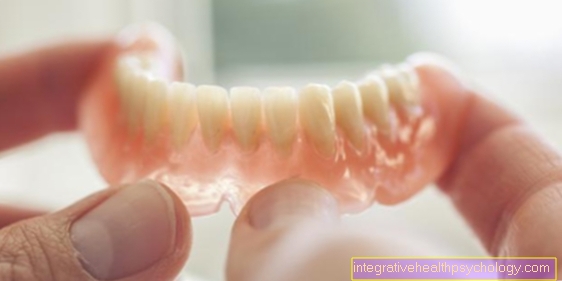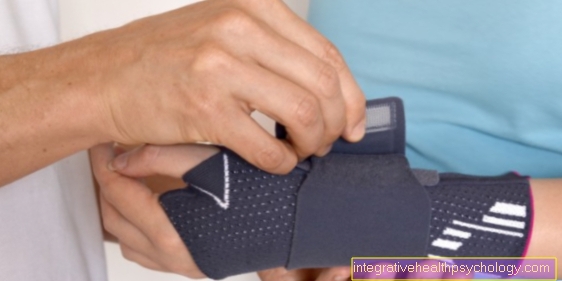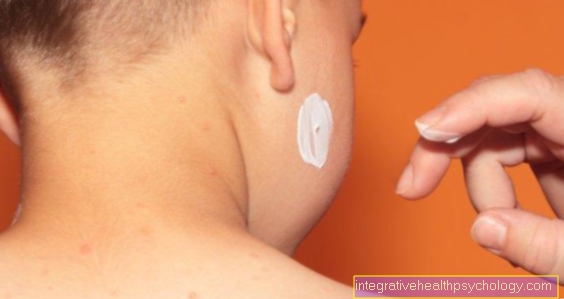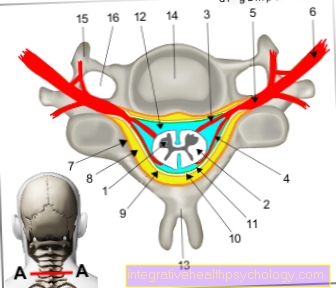Gluing dentures
introduction
A broken prosthesis represents an uncomfortable situation for those affected, which means that they can no longer go about their usual daily routine. Without a prosthesis, the affected person is usually not able to speak, drink and eat as usual.

In addition, one is severely impaired in terms of aesthetics and would prefer not to meet any other person. In any case, a dentist must be visited. Independent gluing, for example with secondary glue, does not make sense and entails many risks.
Read more on the topic: Denture
Can the prosthesis be glued again?
Unfortunately there is no way to glue a prosthesis yourself. Often the fragments cannot be inserted without a gap and interfere with each other so that they cannot even be introduced into the mouth. If the patient uses glue to connect the individual parts outside of the mouth, he will not be able to join the fragments together correctly and the prosthesis may no longer fit in the mouth at all
In most cases, the prosthesis can be repaired or glued by qualified personnel. In any case, you should visit a dentist who will give the prosthesis to a dental laboratory for repair. The dentist has to decide whether a repair is possible or whether it makes sense to create a new denture. If the prosthesis has broken into many small pieces, you have to think about making a new one, as gluing often does not lead to a satisfactory result.
There is also the possibility that the prosthesis is older and that the toothless jaw has deformed so much over time that a perfect fit of the prosthesis and jaw can no longer be guaranteed. In such cases, the prosthesis must also be relined.
Read more on the topic: Reline a denture
If the dentist decides to repair the prosthesis, he must take an impression of the jaw and an impression of the prosthesis. For this purpose, an impression spoon is filled with a putty-like impression material, which is then inserted into the patient's mouth and must remain there for a few minutes until it hardens. These impressions are then given to a dental laboratory and serve as a template for the dental technician for the actual patient situation in the mouth. The repair usually takes a few hours to a day and until then the patient unfortunately has to do without his prosthesis or, ideally, has a replacement prosthesis on hand, which will serve as a replacement until the repair is complete.
How much does a repair by the dental technician cost?
The health insurance company pays part of the costs of any repairs, provided it is not their own fault, the patient only pays an own contribution. As a rule, a break repair of the plastic costs 80-120 euros deductible. If a plastic tooth that has been knocked out has to be replaced, it costs around 70-100 euros. If a metal bracket or a metal element is broken, the repair is more complex because the metal parts have to be soldered. The price for this is around 150-200 euros.
Disadvantages of gluing
If a prosthesis has been repaired, it must be assumed that the material at the point of repair is somewhat weakened and is accordingly more prone to break again. In most cases, the break did not happen in one of these places without a reason. It is possible that the material was kept rather thin there. During the repair, this possibly too thin area is now made more massive, which can have a negative effect on patient comfort.
For many ptothesis wearers, it is uncomfortable if parts of the prosthesis are made very thick, since in this case a foreign body sensation can arise. In addition, the breaking point can be reinforced with metal wires or plates, which in turn requires a thicker design with plastic and increases the weight of the prosthesis. This has a negative effect, especially for a full maxillary denture, since gravity can lead to a reduced hold.
Another disadvantage is that, due to the dental laboratory work, the patient has to wait at least half a day for the prosthesis and, furthermore, costs are to be expected.
Which super glue can you use?
Under no circumstances should the prosthesis be glued with superglue! If the prosthesis is broken, a dentist must be consulted in any case. The repair takes place in a dental laboratory and goes far beyond simply gluing with superglue. The plastic used consists of many individual molecules, so-called monomers, which combine to form polymers (polymerisation). During a repair, the fracture gap is generously ground out and a new denture base is modeled with the above-mentioned material, which then has to be hardened and processed in further steps. If the prosthesis also consists of a metal base or has anchoring elements made of metal, it may be necessary that parts have to be soldered or glued.
Why is self-gluing dangerous?
All-purpose glue or superglue are not suitable for contact with the mucous membrane and can cause allergies and irritation. The adhesives contain many preservatives and plastics, to which many people are allergic because they are not suitable as cosmetic or medical products for the skin or mucous membranes. The allergy can manifest itself in anaphylactic shock, which is life-threatening. The patient gets breathlessness and the mucous membranes swell up. A rash forms and the heart rate increases. If no antiallergic drug is administered, the patient dies within a short time.
Read more on the topic: Anaphylactic shock
In addition, the adhesive is never stable enough to fix the prosthesis in the long term and to ensure stability. It is very possible that it will break again after a short time if something hard is eaten. The chewing stability can never be completely given by the fracture point, since the adhesive does not optimally bond the prosthesis. Furthermore, bacteria can settle in the gap in spite of the adhesive, as the prosthesis is not one hundred percent tight at the break point.
These bacteria can inflame the lining and cause pain. The bacteria can also get tartar and leftover food in the gap and cause unsightly black discoloration. Furthermore, the adhesive can attack the denture plastic and damage the structure, so that a large part of the denture has to be removed. There is a risk that the repair would become much more complex and expensive, or that the prosthesis might even have to be rebuilt
Can you use Pattex?
In an emergency, many of those affected want to act quickly and use superglue (mostly Pattex), which they keep in the household. It is urgently advisable not to attempt to bond the prosthesis yourself, as an exact reduction is hardly possible and there is a risk that the prosthesis will be incorrectly bonded together. In addition, it is often not possible to see directly whether any small fragments have broken off, which also makes precise repositioning impossible. If the prosthesis is now glued together incorrectly, it will not sit properly and the hold is reduced or pressure points can develop.
Bonding with conventional superglue does not offer a permanent hold and there is a possibility that the adhesive is harmful to health. When gluing in a self-experiment, gaps can arise in which dirt and bacteria nest and thus damage the prosthesis material or lead to unpleasant smells.
What can you do to temporarily bond the prosthesis?
The only way to temporarily fix the prosthesis is to use prosthesis adhesive cream or gel. These adhesives can fix the prosthesis parts together for a short time, even if only unstably, so that the prosthesis can at least be worn on the way to the dentist. Furthermore, these adhesives are especially suitable for the oral cavity and are not harmful to health. Other agents such as glue or the like can damage the plastic, so that large parts have to be removed and, in the worst case, the prosthesis has to be rebuilt.
Read more on the topic: Denture adhesive
In addition, they are hazardous to health or even carcinogenic. Therefore it is not recommended. If the prosthesis breaks, the person affected should quickly take all fragments to the dentist, who if necessary will take an impression of the prosthesis and quickly pass the repair on to the dental technician.





























